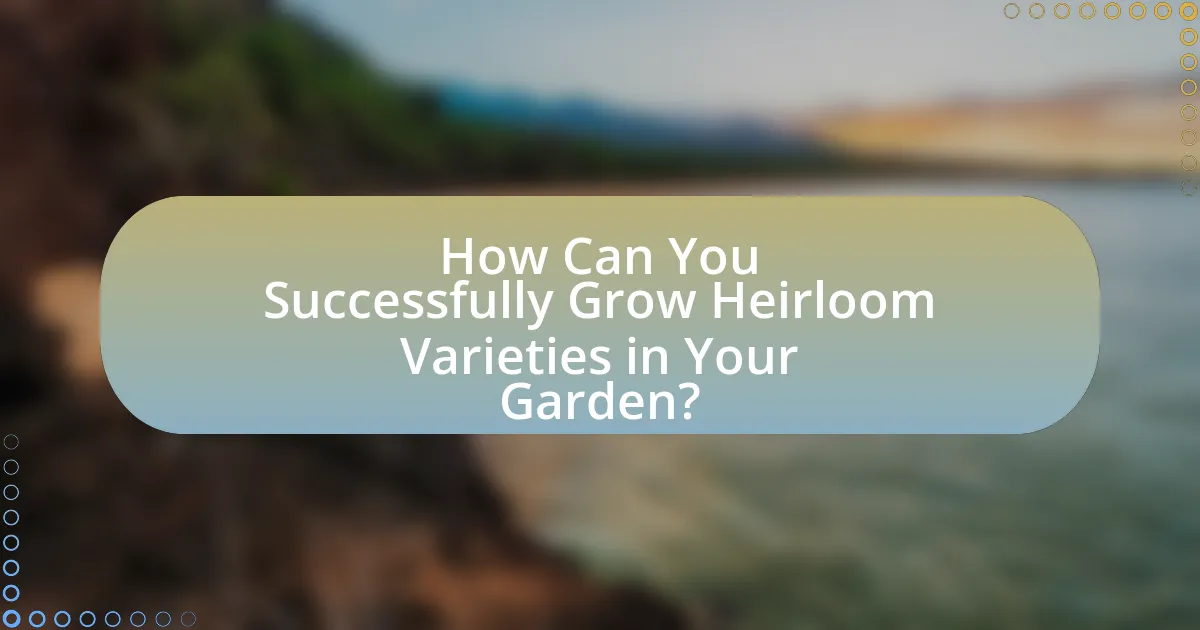Heirloom varieties are traditional plant cultivars that have been passed down through generations, valued for their unique flavors, colors, and resilience. This article outlines the significance of growing heirloom varieties, highlighting their benefits such as superior taste, contribution to biodiversity, and adaptability to local conditions. It also distinguishes heirloom varieties from hybrids, discusses their historical importance, and provides a list of the top 10 heirloom varieties to cultivate in home gardens, including notable options like Brandywine and Cherokee Purple tomatoes. Additionally, the article offers practical tips for successfully growing heirloom plants, addressing common challenges and best practices for maintaining their health and productivity.

What are Heirloom Varieties and Why Should You Grow Them?
Heirloom varieties are traditional plant cultivars that have been passed down through generations, often valued for their unique flavors, colors, and resilience. Growing heirloom varieties is beneficial because they typically offer superior taste compared to commercial hybrids, contribute to biodiversity, and can be adapted to local growing conditions. For instance, heirloom tomatoes, such as Brandywine, are renowned for their rich flavor and are often preferred by chefs and home cooks alike. Additionally, heirloom plants often have a history of being open-pollinated, meaning they can be saved and replanted year after year, promoting sustainable gardening practices.
What defines an heirloom variety?
An heirloom variety is defined as a plant cultivar that has been passed down through generations, typically for at least 50 years, and is valued for its unique characteristics and historical significance. These varieties are often open-pollinated, meaning they can reproduce true to type, allowing gardeners to save seeds for future planting. The preservation of heirloom varieties contributes to biodiversity and maintains genetic diversity in agriculture, as they often possess traits that are well-suited to local growing conditions and have adapted over time.
How do heirloom varieties differ from hybrid varieties?
Heirloom varieties differ from hybrid varieties primarily in their genetic makeup and breeding processes. Heirloom varieties are open-pollinated, meaning they are pollinated naturally and can be saved and replanted, preserving their genetic traits over generations. In contrast, hybrid varieties are created through controlled cross-pollination between different plant species or varieties, often resulting in offspring that exhibit specific desired traits but cannot reliably reproduce those traits in subsequent generations. This distinction is significant as heirloom varieties often have a broader genetic diversity and are valued for their unique flavors and historical significance, while hybrids are typically bred for uniformity, disease resistance, and higher yields.
What are the historical significance and benefits of heirloom varieties?
Heirloom varieties hold historical significance as they represent traditional plant breeds that have been cultivated and passed down through generations, often for over 50 years. These varieties are valued for their genetic diversity, which contributes to agricultural resilience and adaptability in changing climates. The benefits of heirloom varieties include superior flavor, unique characteristics, and the preservation of cultural heritage, as they often reflect the agricultural practices and preferences of specific regions or communities. For example, heirloom tomatoes, such as the Brandywine variety, are renowned for their rich taste and have been cultivated since the 19th century, showcasing the importance of maintaining these varieties for both culinary and historical reasons.
Why are heirloom varieties important for home gardeners?
Heirloom varieties are important for home gardeners because they offer unique flavors, diverse genetics, and a connection to agricultural history. These varieties, often passed down through generations, provide distinct tastes that are often superior to commercial hybrids. Additionally, heirloom plants contribute to biodiversity, which is crucial for ecosystem resilience and adaptability to changing environmental conditions. Studies have shown that growing a variety of heirloom crops can enhance soil health and promote beneficial insect populations, further supporting sustainable gardening practices.
How do heirloom varieties contribute to biodiversity?
Heirloom varieties contribute to biodiversity by preserving genetic diversity within plant species. These varieties, often passed down through generations, maintain unique traits that may be lost in commercial hybrid crops. For instance, heirloom tomatoes exhibit a wide range of colors, flavors, and resistance to local pests, which enhances ecosystem resilience. Research indicates that maintaining diverse heirloom crops can improve soil health and promote beneficial insects, thereby supporting overall agricultural biodiversity.
What flavors and qualities do heirloom varieties offer compared to modern varieties?
Heirloom varieties offer richer and more diverse flavors compared to modern varieties, which often prioritize uniformity and shelf life. Heirloom tomatoes, for example, are known for their complex taste profiles, ranging from sweet to tangy, while modern hybrids tend to have a more bland flavor due to selective breeding for durability and transportability. Additionally, heirloom varieties often possess unique qualities such as varied colors, shapes, and sizes, which contribute to their appeal in home gardens. Research indicates that heirloom crops can also have higher nutritional value, as they are often grown in diverse conditions that enhance their flavor and health benefits.

Which are the Top 10 Heirloom Varieties to Grow in Your Home Garden?
The top 10 heirloom varieties to grow in your home garden are Brandywine Tomato, Cherokee Purple Tomato, Green Zebra Tomato, Black Krim Tomato, Lemon Cucumber, Boston Marrow Squash, Dragon Tongue Bean, Purple Podded Pea, Chioggia Beet, and Paris Market Carrot. These varieties are celebrated for their unique flavors, historical significance, and adaptability to home gardening. For instance, Brandywine tomatoes are known for their rich taste and large size, while Cherokee Purple tomatoes are prized for their deep color and sweetness. Each of these heirloom varieties has been cultivated for generations, ensuring their resilience and flavor, making them ideal choices for home gardeners seeking to preserve biodiversity and enjoy exceptional produce.
What are the top heirloom tomato varieties to consider?
The top heirloom tomato varieties to consider include Brandywine, Cherokee Purple, Green Zebra, and Black Krim. Brandywine is renowned for its large, flavorful fruits and is often regarded as one of the best-tasting tomatoes. Cherokee Purple is celebrated for its rich, sweet flavor and unique dark color. Green Zebra offers a tangy taste with its distinctive green and yellow stripes, while Black Krim is known for its deep, smoky flavor and dark color. These varieties are favored for their exceptional taste and historical significance in gardening.
What makes Brandywine tomatoes a favorite among gardeners?
Brandywine tomatoes are a favorite among gardeners due to their exceptional flavor and large, juicy fruit. This heirloom variety is known for its rich, sweet taste, which is often described as one of the best among tomatoes. Additionally, Brandywine tomatoes produce substantial yields, making them a rewarding choice for home gardeners. Their adaptability to various growing conditions and resistance to certain diseases further enhance their popularity. The historical significance of Brandywine tomatoes, having been cultivated since the 1800s, adds to their appeal, as many gardeners appreciate growing varieties with a storied past.
How do Cherokee Purple tomatoes stand out in flavor and appearance?
Cherokee Purple tomatoes are distinguished by their rich, sweet flavor and unique, dark purple-red appearance. The flavor profile is often described as complex, with a balance of sweetness and acidity that enhances their culinary versatility. In terms of appearance, these tomatoes feature a deep, dusky color with green shoulders, which sets them apart from more common tomato varieties. Their distinctive coloration and exceptional taste have made them a favorite among heirloom tomato enthusiasts and chefs alike.
What heirloom vegetable varieties are best for beginners?
The best heirloom vegetable varieties for beginners include ‘Brandywine’ tomatoes, ‘Kentucky Wonder’ beans, ‘Lacinato’ kale, ‘Chioggia’ beets, and ‘Yellow Crookneck’ squash. These varieties are known for their ease of growth, resilience, and ability to thrive in various conditions. For instance, ‘Brandywine’ tomatoes are popular for their rich flavor and adaptability, while ‘Kentucky Wonder’ beans are prolific and require minimal care. ‘Lacinato’ kale is tolerant of cold weather, making it suitable for early and late planting. ‘Chioggia’ beets are visually appealing and straightforward to cultivate, and ‘Yellow Crookneck’ squash is known for its high yield and disease resistance. These characteristics make them ideal choices for novice gardeners looking to successfully grow heirloom vegetables.
Why is the Yellow Crookneck Squash a great choice for novice gardeners?
The Yellow Crookneck Squash is a great choice for novice gardeners because it is easy to grow and requires minimal maintenance. This squash variety thrives in a range of soil types and can be planted in both gardens and containers, making it versatile for different gardening setups. Additionally, it has a relatively short growing season of about 60 days, allowing novice gardeners to see quick results and build confidence. Its resistance to common pests and diseases further simplifies the gardening process, making it an ideal option for those new to gardening.
How does the French Breakfast Radish thrive in home gardens?
The French Breakfast Radish thrives in home gardens by requiring well-drained soil, consistent moisture, and full sun exposure. This radish variety grows best in temperatures between 50°F and 70°F, allowing for rapid growth and optimal flavor development. Additionally, it matures quickly, typically within 25 to 30 days, making it suitable for successive planting throughout the growing season. The French Breakfast Radish is also resistant to bolting, which means it can produce a harvest even in warmer conditions, further enhancing its viability in home gardens.
What unique heirloom fruit varieties can enhance your garden?
Unique heirloom fruit varieties that can enhance your garden include the Black Krim tomato, which is known for its rich flavor and high antioxidant content, and the Cherokee Purple tomato, celebrated for its sweet, complex taste and historical significance. Other notable varieties are the Pineapple tomato, recognized for its unique yellow and red striped appearance and fruity flavor, and the Brandywine tomato, which is prized for its large size and exceptional taste. Additionally, the Arkansas Black apple offers a crisp texture and excellent storage capabilities, while the Blueberry tomato provides a unique color and sweet flavor profile. These heirloom varieties not only contribute to biodiversity but also offer unique flavors and textures that can elevate the overall quality of your garden produce.
What are the benefits of growing heirloom strawberries?
Growing heirloom strawberries offers several benefits, including superior flavor, biodiversity, and adaptability to local growing conditions. Heirloom strawberries are known for their rich taste, often surpassing that of commercial varieties, which can enhance culinary experiences. Additionally, these strawberries contribute to biodiversity by preserving unique genetic traits that may be lost in hybrid varieties, promoting ecological resilience. Furthermore, heirloom varieties are often better suited to specific climates and soils, allowing for more successful cultivation in diverse home garden settings.
How do heirloom apple varieties differ from commercial ones?
Heirloom apple varieties differ from commercial ones primarily in their genetic diversity and flavor profiles. Heirloom apples are often open-pollinated, meaning they are grown from seeds of parent trees that have been cultivated for generations, resulting in unique flavors and textures that are not typically found in commercial varieties. In contrast, commercial apples are usually bred for uniformity, shelf life, and resistance to pests, leading to a more standardized taste and appearance. For example, heirloom varieties like ‘Gravenstein’ and ‘Cox Orange Pippin’ are celebrated for their complex flavors, while commercial varieties like ‘Gala’ and ‘Fuji’ prioritize consistency and durability for mass distribution.

How Can You Successfully Grow Heirloom Varieties in Your Garden?
To successfully grow heirloom varieties in your garden, select a suitable location with well-draining soil and ample sunlight, ideally six to eight hours per day. Heirloom varieties thrive in nutrient-rich soil, so amend it with organic matter like compost before planting. Additionally, ensure proper spacing between plants to promote air circulation and reduce disease risk. Regular watering is crucial, especially during dry spells, but avoid overwatering to prevent root rot. Pest management should be proactive; consider companion planting and organic pest control methods to protect heirloom crops. According to the USDA, heirloom varieties often have better flavor and nutritional value compared to hybrid counterparts, making them a worthwhile addition to any garden.
What are the best practices for planting heirloom seeds?
The best practices for planting heirloom seeds include selecting high-quality seeds, preparing the soil adequately, and ensuring proper planting depth and spacing. High-quality heirloom seeds are often open-pollinated and can be saved for future planting, making them a sustainable choice. Soil preparation involves testing pH levels and enriching the soil with organic matter to promote healthy growth. Planting depth varies by seed type, but generally, seeds should be sown at a depth of two to three times their diameter, and spacing should follow specific guidelines to prevent overcrowding, which can lead to disease. These practices enhance germination rates and overall plant health, ensuring a successful heirloom garden.
How should you prepare your soil for heirloom varieties?
To prepare your soil for heirloom varieties, start by testing the soil pH and nutrient levels to ensure optimal growing conditions, ideally between 6.0 and 7.0 pH. This is crucial because heirloom plants often require specific nutrient profiles to thrive. Amend the soil with organic matter, such as compost or well-rotted manure, to improve soil structure and fertility, which enhances moisture retention and provides essential nutrients. Additionally, ensure proper drainage by incorporating sand or perlite if the soil is heavy clay. These practices are supported by agricultural studies indicating that well-prepared soil significantly increases the yield and health of heirloom crops.
What is the ideal planting time for different heirloom varieties?
The ideal planting time for different heirloom varieties generally falls between late spring and early summer, depending on the specific variety and local climate conditions. For instance, heirloom tomatoes should be planted after the last frost date, typically around mid to late May in most regions, while heirloom beans can be sown directly into the soil once the soil temperature reaches at least 60°F, usually in late spring. Additionally, heirloom peppers thrive when planted in warm soil, ideally in late spring, after the risk of frost has passed. These planting times are crucial for ensuring optimal growth and yield, as they align with the plants’ natural growing cycles and local weather patterns.
How can you ensure the health and productivity of heirloom plants?
To ensure the health and productivity of heirloom plants, provide them with optimal growing conditions, including well-drained soil, adequate sunlight, and consistent watering. Heirloom plants thrive in nutrient-rich soil, so incorporating organic matter like compost can enhance soil fertility. Regular monitoring for pests and diseases is essential; using organic pest control methods can help maintain plant health. Additionally, practicing crop rotation and companion planting can improve resilience and yield. Research indicates that heirloom varieties often have better flavor and nutritional value, making their proper care crucial for maximizing their benefits in home gardens.
What are effective pest management strategies for heirloom varieties?
Effective pest management strategies for heirloom varieties include integrated pest management (IPM), which combines cultural, biological, and chemical methods to control pests. Cultural practices such as crop rotation, companion planting, and maintaining soil health can reduce pest populations. Biological control involves introducing natural predators or parasites to manage pest species, while targeted chemical treatments, when necessary, should focus on organic options to minimize harm to heirloom plants. Research indicates that IPM can reduce pest damage by up to 50% while promoting biodiversity and sustainability in gardening practices.
How can you support heirloom plants during their growth cycle?
To support heirloom plants during their growth cycle, provide consistent watering, appropriate sunlight, and nutrient-rich soil. Heirloom plants thrive with regular moisture, ideally 1-2 inches per week, which helps prevent stress and promotes healthy growth. They require full sun, meaning at least six hours of direct sunlight daily, to ensure optimal photosynthesis. Additionally, enriching the soil with organic matter, such as compost, enhances nutrient availability, which is crucial for the development of these traditional varieties. Studies show that heirloom plants often have specific nutrient needs that differ from hybrid varieties, making soil quality a key factor in their successful cultivation.
What common challenges might you face when growing heirloom varieties?
Growing heirloom varieties presents several common challenges, including susceptibility to pests and diseases, inconsistent yields, and specific growing conditions. Heirloom plants often lack the genetic modifications found in commercial varieties, making them more vulnerable to pests like aphids and diseases such as blight. Additionally, heirloom varieties may require particular soil types, moisture levels, and climate conditions, which can complicate their cultivation. Research indicates that heirloom crops can yield less consistently compared to hybrid varieties, which are bred for uniformity and resilience. These factors necessitate careful management and attention from gardeners to ensure successful growth.
How can you troubleshoot issues with heirloom plants?
To troubleshoot issues with heirloom plants, first identify the specific symptoms such as wilting, discoloration, or stunted growth. Once symptoms are recognized, assess environmental factors including soil quality, moisture levels, and sunlight exposure, as these can significantly impact plant health. For instance, heirloom tomatoes thrive in well-drained soil with full sun, and inadequate conditions can lead to poor growth. Additionally, inspect for pests or diseases, as heirloom varieties may be more susceptible due to their genetic diversity. Implementing organic pest control methods or adjusting care practices can effectively resolve these issues. Regular monitoring and adjustments based on observed plant responses will enhance the success of growing heirloom varieties.
What are the signs of disease in heirloom varieties and how can you address them?
Signs of disease in heirloom varieties include yellowing leaves, wilting, stunted growth, and the presence of spots or lesions on leaves and stems. To address these issues, gardeners should first identify the specific disease affecting the plants, which can often be done through visual inspection or by consulting agricultural extension services. Once identified, appropriate measures such as removing infected plant parts, improving air circulation, applying fungicides or insecticides, and ensuring proper watering practices can be implemented to mitigate the disease’s impact. Regular monitoring and maintaining healthy soil conditions also play a crucial role in preventing disease in heirloom varieties.
What tips can help you maximize your heirloom gardening experience?
To maximize your heirloom gardening experience, focus on selecting diverse heirloom varieties that are well-suited to your local climate and soil conditions. This approach enhances biodiversity and resilience in your garden. Research indicates that heirloom plants often possess unique flavors and characteristics, making them more rewarding to grow and consume. Additionally, practicing crop rotation and companion planting can improve soil health and pest management, further optimizing your gardening results. Engaging with local gardening communities can provide valuable insights and support, enriching your heirloom gardening journey.





